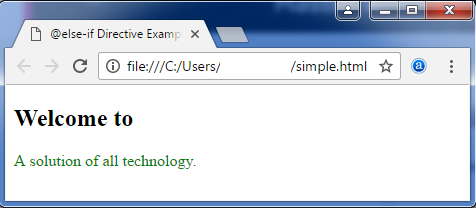当@if指令失败时, 使用Sass @ else-if指令。如果失败, 则使用@else指令。
SCSS语法:
$type: monster;
p {
@if $type == ocean {
color: blue;
} @else if $type == matador {
color: red;
} @else if $type == monster {
color: green;
} @else {
color: black;
}
}编译后, 它将创建一个具有以下代码的CSS文件:
CSS语法:
让我们以一个示例来演示Sass @ else-if指令的用法。我们有一个名为” simple.html”的HTML文件, 其中包含以下数据。
HTML档案:simple.html
<!DOCTYPE html>
<html>
<head>
<title>@if Directive Example</title>
<link rel="stylesheet" type="text/css" href="simple.css"/>
</head>
<body>
<div class="container">
<h2>Welcome to srcmini</h2>
<p>A solution of all technology. </p>
</div>
</body>
</html>创建一个名为” simple.scss”的SCSS文件, 其中包含以下数据。
SCSS文件:simple.scss
$type: monster;
p {
@if $type == ocean {
color: blue;
} @else if $type == matador {
color: red;
} @else if $type == monster {
color: green;
} @else {
color: black;
}
}将两个文件都放在根文件夹中。
现在, 打开命令提示符并运行watch命令, 以告知SASS监视文件并在更改SASS文件时更新CSS。
执行以下代码:sass –watch simple.scss:simple.css
它将在同一目录中自动创建一个名为” simple.css”的普通CSS文件。
例如:

创建的CSS文件” simple.css”包含以下代码:
p {
color: green; }现在, 执行上面的html文件, 它将读取CSS值。
输出

 srcmini
srcmini
评论前必须登录!
注册